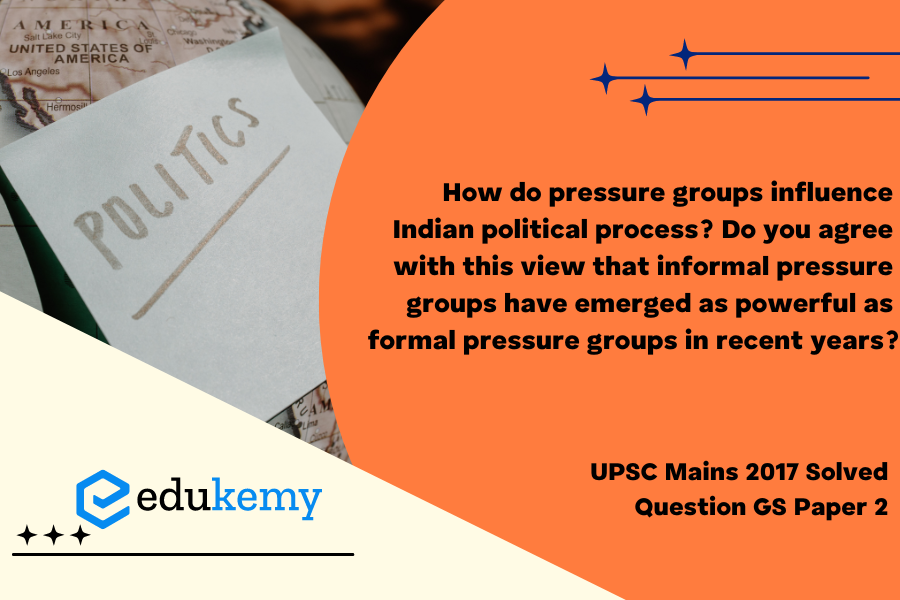Pressure groups play a pivotal role in shaping the Indian political landscape, exerting influence on policy formulation and decision-making. These groups, comprising both formal entities like industry associations and informal ones such as civil society organizations, employ various strategies to advance their interests. Formal pressure groups often leverage established channels, such as lobbying and direct engagement with policymakers, to shape legislation and government actions. However, in recent years, the rise of informal pressure groups has sparked debates about their comparable impact. Informal groups, often rooted in grassroots movements and social media activism, have demonstrated a remarkable ability to mobilize public opinion and effect change. The question of whether informal pressure groups now wield power equivalent to their formal counterparts is a complex one, requiring a nuanced evaluation of their tactics, reach, and overall impact on the Indian political process.
Tag: Governance; The role of various groups and associations.
Contents
Decoding the Question:
- In the Introduction, try to define ‘pressure groups’.
- In Body,
- Write various ways in which these influence the Indian political process.
- Write about the emergence of powerful formal pressure groups in recent times along with some issues.
- Conclude by writing the overall importance of pressure groups in the Indian political system.
Answer:
A pressure group is an organization formed when people with common occupations, interests, aspirations, or opinions come together to achieve a common objective. It is an interest group whose members have shared common interests and which organize themselves and claim on the other groups and the political process. For example: Trade unions, students’ groups, etc.
How do pressure groups exert influence?
- Lobbying via petitions, letters, and deputations; Business groups like The Federation of Indian Chambers of Commerce & Industry (FICCI) and Confederation of Indian Industry (CII) exert pressure to influence planning and business policies.
- Consulting with ministers or senior public servants; various community and religious groups use it for achieving their interests.
- Taking legal action through injunctions or appeals to higher courts; For example: Association for Democratic Reforms (ADR), etc.
- Campaigning & Demonstrating- many farmers and students’ groups like- All India Kisan Party, All India Students Federation, etc. For demands like Agrarian policies and educational issues.
- Using strikes for political purposes: Trade unions like All India Trade Union Congress (AITUC) exert pressure for monetary gains (increase in wages, bonuses, etc.)
- Public opinion and Electioneering: these are agencies of interest aggregation, political communication, political socialization, and public opinion. They also place people who favor their interests in public offices.
They do not contest elections and do not try to capture:
- Political power; Instead their activities are confined to the protection and promotion of the interests of their members by influencing the Government.
- The pressure groups influence the policy-making and policy implementation in the government through legal and legitimate methods like lobbying, correspondence, publicity, propagandizing, petitioning, public debating, and maintaining contacts with their legislators.
- The Pressure groups keep the administrative machinery accountable, by resorting to three techniques for securing their purposes: Electioneering: placing persons in public office who are favorably disposed towards their interests.
- Members are often very passionate, they may resort to undesirable tactics like violence or criminal behavior to promote their cause.

Examples of powerful roles:
- Narmada Bachao Andolan: With the active participation of tribals, environmentalists, human rights activists, and local people, it protected the river ecosystem from the construction of a large dam.
- Lokpal Act: Many Civil Society activists like Anna Hazare persuaded the government to form an independent investigation body to inquire into corruption cases by performing strikes and demonstrations.
- Nirbhaya Movement: A large group of people comprising students, women’s rights activists, parents’ associations etc., through demonstration, brought reforms in the justice delivery system of crimes against women.
Limitations/challenges:
- Despite the success, these groups suffer from issues like lack of effective leadership and autonomous existence, and unstable structure.
- These often indulge in mass violence, use Unconstitutional methods, focus on parochial interests, etc., which creates a serious threat to the democratic setup.
In the complexities of modern government, and the pluralistic nature of society, pressure groups play a vital role and provide a means by which ordinary citizens can participate in the decision-making process, as well as maintain a check on government activity. These are an indispensable and helpful element of the Indian political system. Hence, there is a need for better organization and influence of pressure groups, with clearly defined aims, to be able to make a difference.
In case you still have your doubts, contact us on 9811333901.
For UPSC Prelims Resources, Click here
For Daily Updates and Study Material:
Join our Telegram Channel – Edukemy for IAS
- 1. Learn through Videos – here
- 2. Be Exam Ready by Practicing Daily MCQs – here
- 3. Daily Newsletter – Get all your Current Affairs Covered – here
- 4. Mains Answer Writing Practice – here


